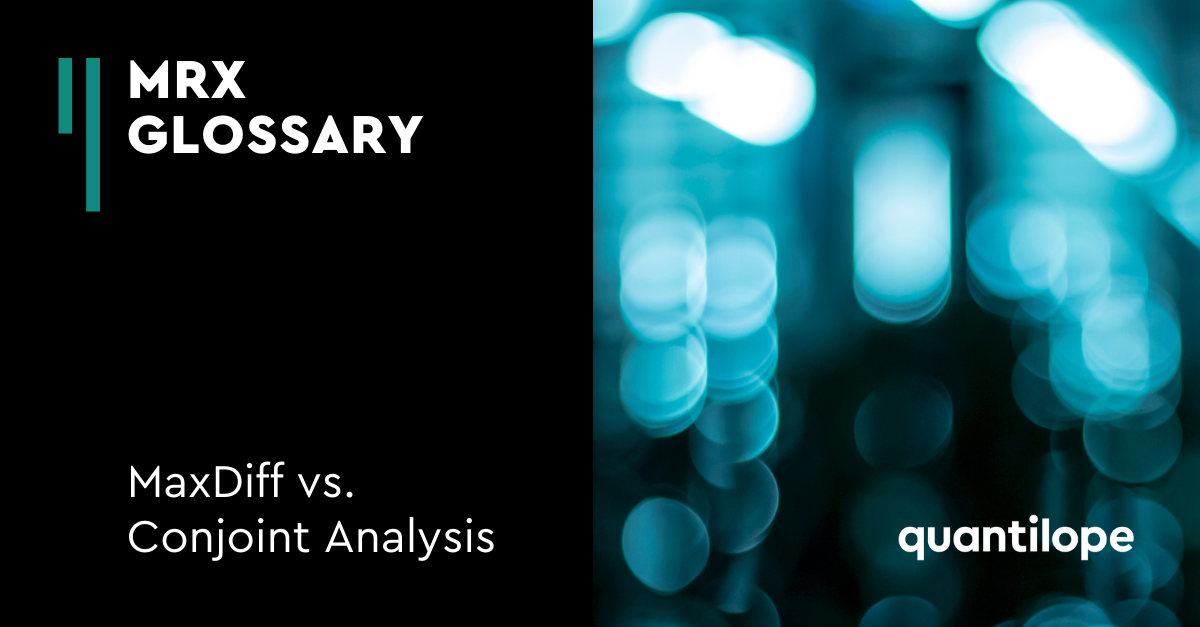In this blog post, learn the main differences between two very commonly used advanced research methodologies: MaxDiff and Conjoint analysis, and when to leverage each.
Table of Contents:
- MaxDiff vs. Conjoint
- What is a MaxDiff analysis?
- Why choose MaxDiff analysis?
- Example of a MaxDiff analysis
- What is a Conjoint analysis?
- Why choose Conjoint analysis?
- Example of a Conjoint analysis
- When to use MaxDiff vs. Conjoint
- Automate MaxDiff and Conjoint Analysis with quantilope
MaxDiff vs. Conjoint
Do you know your MaxDiff from your Conjoint?
MaxDiff Analysis (also known as Best-Worst Scaling) and Conjoint Analysis have some characteristics in common, but they also have some key differences that are worth understanding so you choose the best method for your research needs.
Both approaches force respondents to make trade-offs between items and can identify which items (or factors, or attributes) drive take-up of a product or service. The factors could be any elements within an offer - for example, product attributes like style, color, and taste. Both also deliver interval-scaled utility scores*, which show how important each item is - which is great information to have for optimizing a value proposition.
*Note there are much more complex calculations that occur for these methods on the backend, but gives you an idea of the output.
Back to Table of Contents
What is a MaxDiff analysis?
MaxDiff is a simpler research method. By showing respondents multiple sets of attributes and forcing them to make trade-offs, MaxDiff reveals customer preferences and the relative importance of each item. For example, if you were looking to make sure your range of jeans includes styles that appeal to all sub-groups of your target audience, you might show lists of attributes such as ‘color’, ‘fit’, ‘length’, ‘waistband height’, and ‘brand’.
To avoid participants having to assess a long list of items and choose which are most and least important to them, they would instead be shown three or four attributes at a time, with a rotating combination of items on each screen. MaxDiff takes the preference scores for each attribute and presents them in bar chart format, which allows us to see two crucial aspects: the relative rank of items in order of importance, and the magnitude of those items' importance relative to each other. Typically, MaxDiff will research attributes at one level only - so for our jeans scenario, the trade-offs respondents have made will reveal whether the ‘fit’ is much more of a deal-breaker than ‘color’, or where the aspect of ‘brand’ fits into the overall ranking. Variations, or levels, within those attributes (blue/black/indigo/white, skinny/slim/regular etc.) will not be included.
Back to Table of Contents
Why choose MaxDiff analysis?
MaxDiff Analysis is useful for any project that aims to identify true preferences amongst a long list of attributes. As you might guess, the results from this forced trade-off exercise are much more insightful than having respondents select from a long list of multiple-choice responses where they may say that everything is important to them. While it's true everything might be important to consumers in some capacity, brands are going to want to know what is most important, or more important than other elements in an offer. In other words, MaxDiff comes up with the 'must-haves' versus the 'nice-to-haves' and the 'not-needed' characteristics of a product or service.
MaxDiff is really useful at the development stage of a product or service offering, as the ranking and relative importance of characteristics can guide the product/service design. MaxDiff gives a good foundational understanding of how various attributes rank in consumers' minds, which creates a solid picture of what they'll look for when they actually go out shopping. One use case where MaxDiff falls short is pricing: it is not designed to fully evaluate how price fits into consumer preferences; for this, a Conjoint or pricing method like PSM/Van Westendorp would be better suited.
Back to Table of Contents
Example of a Maxdiff analysis
A MaxDiff analysis ranks attributes in a way that helps a business focus on the elements that matter most to consumers. So in our jeans example above, the brand might have noticed a trend in the market for tighter jeans with a higher waistband. If they're designing new products for the teenage market, the brand will want to know whether these aspects are definitely what their target age group is looking for. In a MaxDiff study amongst teenagers, the analysis could ask respondents to make tradeoffs between the following aspects of a pair of jeans:
- color
- length
- brand
- waistband height
- fit
In this case, let's say teenage respondents actually prioritize the color of jeans and the brand name over length, waistband, and overall fit. Using these insights, the marketing team and product design will now focus on color and brand logo as two major drivers of purchase. Further research might even be conducted to determine which specific colors and types of branding (i.e. large logo, colorful logo, minimalist branding, etc.) would drive purchasing.
Back to Table of Contents
What is a Conjoint analysis?
A conjoint analysis allows users to understand how important different attributes in a product are and how brands can optimize those attributes to capture the most share within a given market. In a Conjoint, respondents are presented with different configurations of products, services, or concepts (e.g. Product A, Product B, and Product C) and asked which one they would opt for. Product A might be a tight-fitting, black, high-waisted pair of jeans with rips in them. Product B could be a baggy, stonewashed, low-rise pair of jeans. Product C might be white, high-waisted, bootlegged pair.
By asking respondents to choose their favorite product (multiple times within the survey), their preferred attributes are inferred, so that brands can deduce which set of attributes are most attractive to them in each product*. This methodology means that the data can be presented and modeled in a more versatile way than with MaxDiff; you have the ability to understand and compare the importance of individual attributes (like a MaxDiff), but you can also test different combinations of attributes to evaluate the potential success of entire product concepts.
*This just begins to describe the power of a Conjoint Analysis. For more on what this advanced research method can do, check out this page.
Why choose Conjoint analysis?
Conjoint analysis enables a business to make inferences about the attributes that consumers place the most importance on when choosing a product or service. Instead of directly asking which attributes are most important, Conjoint puts combinations in front of respondents and generates their levels of importance based on observing the behaviors of which product consumers are choosing. Consumers aren't always aware of what their biases are - such as always purchasing the same brand based on nostalgia. This is where Conjoint analysis comes into play - allowing brands to narrow in on the true most impactful aspects of a product.
For example, breakfast cereal: it could be tricky for consumers to determine whether it's the shape of the cereal, the flavor, the sugar content, the added vitamins, or maybe even simple nostalgia for the brand that leads them to purchase it.
However, if respondents are presented with a set of different cereal combinations and asked to choose between them, it becomes clear which aspects are actually impacting consumers' purchasing decisions (including price points, which MaxDiff can't measure!).
Back to Table of Contents
Example of Conjoint analysis
In the breakfast cereal example, respondents might make tradeoffs between these options below, with varying cereal shapes, sugar content, vitamin inclusion, and fiber count:
Package 1: chocolate hoops, 4g of sugar per 30g, vitamins C and D, 7g fiber
Package 2: chocolate flakes, 5g of sugar per 30g, vitamin C, 7g fiber
Package 3: honey hoops, 6g of sugar per 30g, vitamin D, 5g fiber
Package 4: honey flakes, 8g of sugar per 30g, vitamins C and D, 10g fiber
Consumers are asked to pick the product they are most likely to purchase, with the Conjoint analysis mimicking a simple and realistic product decision-making process in-store.
Back to Table of Contents
When to use MaxDiff vs. Conjoint
Though there's a lot more that goes into these methods and that occurs on the backend for highly actionable results, the core of both MaxDiff and Conjoint analysis is: how do particular aspects of my product, service, or category (like attributes, price, or the competitive set) influence consumer decision-making?
Individual elements vs. entire concepts:
Conjoint takes the analysis of attributes within a product or service a step further than MaxDiff. While MaxDiff sheds light on the features or characteristics that are most persuasive in a product or service, Conjoint offers a more nuanced picture of what a successful product or service would look like if it were to be fully developed.
One helpful way of thinking about each technique is that MaxDiff is useful for prioritizing elements of an offer, while Conjoint is useful for optimizing the entire offer. For this reason, MaxDiff is often used as a precursor to Conjoint studies; MaxDiff identifies the attributes that are sought after in a product, while Conjoint puts those attributes into a package that will optimize the share of preference.
Pricing decisions:
Because of its strength in helping the evaluation of product profiles, pricing is often a central question in a Conjoint analysis. Specifically, price elasticity: how potential demand changes in relation to the price. Conjoint also shows which product profiles are appropriate for different price points. So with the above jeans example, the question might be ‘What’s the most we can charge for black, tight, ripped jeans without a significant decrease to share of preference?’ or ‘What happens to price expectations if we change the color to dark blue?’
While the methods differ slightly in optimal use cases, each method can be used for a number of business objectives such as:
- product concept testing
- brand messaging
- product development
- prioritization of product features
- new product testing
- competitive landscape research
- customer satisfaction (including by different customer segments)
Automate MaxDiff and Conjoint Analysis with quantilope
Whichever research method you choose, quantilope’s Insights Automation Platform will ensure quick and actionable results.
quantilope’s AI-powered methodologies can be applied with a drag+drop functionality, making it simple and straightforward for researchers of any background to capture advanced research insights. quantilope’s platform also prioritizes user experience, making it intuitive and enjoyable for respondents to provide their valuable feedback.
MaxDiff projects are simple to set up and results are easy to interpret, as you can see in this demo video. In the case of Conjoint, quantilope offers an intuitive market simulator with customizable scenarios (e.g. what happens to expected sales if you change the price or other attributes within your product profile?) as well as an automated product optimization module to help make the most of your research insights. Take a closer look at quantilope’s Conjoint method here.
MaxDiff and Conjoint Analysis can be hugely powerful in guiding the direction of your product or service. If you’d like to learn more about how to leverage these methodologies for your own business, get in touch below:


